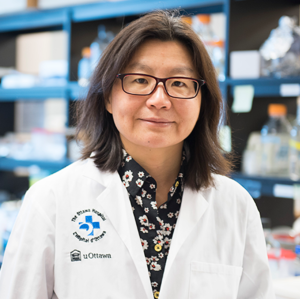 Dr. Hsiao-Huei ChenOne of the most common ways to understand the function of a gene is to breed mice that don’t have the gene and compare them to mice that do. Sometimes, if the gene is essential for survival, it won’t be possible to breed mice without it, but you can still learn something by trying.
Dr. Hsiao-Huei ChenOne of the most common ways to understand the function of a gene is to breed mice that don’t have the gene and compare them to mice that do. Sometimes, if the gene is essential for survival, it won’t be possible to breed mice without it, but you can still learn something by trying.
This is what happened the first time Dr. Hsiao-Huei Chen and Dr. Alexandre Stewart and their team tried to breed mice without an immune system gene called Irf2bp2. After eight years of trying, they were surprised to find that a small number of mice without Irf2bp2 survived. Even more surprisingly, the female survivors had “male” Y chromosome cells in their liver that were producing the IRF2BP2 protein.
How did the male cells get there? The researchers suggest that normal stem cells from older brothers were somehow hanging around in the mom and became incorporated into the embryos of their younger sisters. These female embryos could only survive because they were “chimeras” containing male stem cells with the essential gene.
The researchers believe this is the first example of this kind of “saviour sibling” effect to rescue a lethal genetic deficit. The research, published in Frontiers in Immunology, could have implications for the treatment of inherited diseases, as well as understanding Irf2bp2.
Authors: Vilmundarson RO, Heydarikhorneh N, Duong A, Ho T, Keyhanian K, Soheili F, Chen HH, Stewart AFR.
Funding: Canadian Institutes of Health Research, Natural Sciences and Engineering Research Council of Canada, Canadian Diabetes Association Heart and Stroke Foundation of Canada, Heart and Stroke Foundation of Ontario.
The Ottawa Hospital is a leading academic health, research and learning hospital proudly affiliated with the University of Ottawa and supported by The Ottawa Hospital Foundation.
